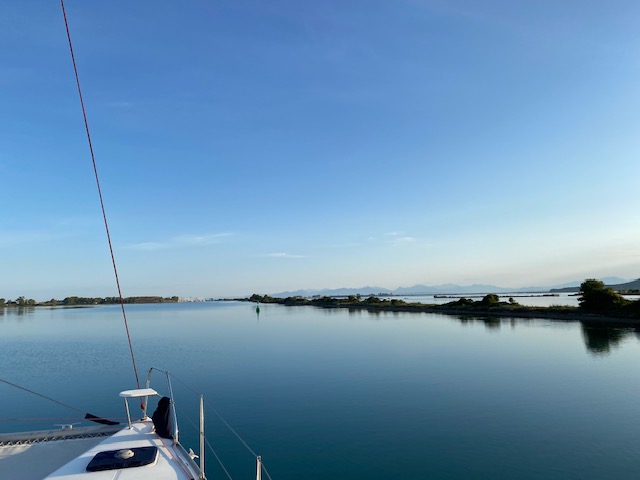As usual we were motoring and the scenery wasn’t particularly spectacular, but pretty enough, nonetheless. However, as we progressed further west, the landscape became more mountainous, with little villages perched high on the mountain tops or cascading down the mountain sides to the sea.
At one point the sea state got quite choppy again, but, thankfully, as we neared our destinations, it settled down.
By midday we were anchored off a very picturesque beachfront resembling a holiday destination, with umbrellas and loungers set out on the beach, and a collection of bars and restaurants. What we couldn’t see, though, were any hotels that looked operational; they all seemed to be boarded up or converted to apartments with small “gardens” on the balconies.
The downside was the number of fishing pods everywhere and the depths didn’t resemble anything that our charts indicated; they were hundreds of feet out and the only shallow areas were right up on the beach. However, in Italy a yacht cannot be anchored closer than 200 metres to any beach. As a result it took us some time to find a shallow enough area to anchor; that turned our to be right in the middle of all the fishing pods, but Elaine found the opening that afforded us plenty of swing room with a 7:1 scope in 20’ and, bonus, the anchorage was protected by the sand spit that formed the arch of the beachfront. The strange thing was that all the local boats were out of the water, pulled up on a section of the beach, probably too deep for them and having the fishing pods on the shallows was more important.
By then, though, neither of us cared about anything going on ashore, not even the small, Byzantine church on the hillside, with 5 brickwork domes & interior frescoes; we needed a nap.
Barely a half an hour later, though, an almighty thunder clap startled us out of our slumber and had us both running in various directions; first to get all the almost dry laundry off the lines, then to start the engines, since we weren’t altogether sure what winds would be associated with the thunderstorm. Unlike Thailand, fortunately, the highest wind speed we recorded was 17 Kts, but it bucketed down, giving Paw Paw a nice freshwater rinse. It had been a while since we were at anchor in a thunderstorm.
While Roy’s short nap had revitalised him somewhat, Elaine went back to bed and only woke at dinner time; all the early mornings had definitely caught up with her. When she did surface, however, there was a racket coming from shore; the usual cacophony of music associated with a holiday destination, although everyone on the beachfront looked like locals as apposed to holidaymakers in their beach attire. When the fireworks went off, it occurred to us that there may well be some sort of celebration going on, especially since Roy remembered it was a public holiday and would explain the fireworks that went off at midnight when we were in Crotone.
Research revealed that it was, in fact, “Festa della Repubblica”, Italy’s National Day. Although the the main celebration takes place in Rome, “Festa della Repubblica” is celebrated throughout the country with parades, fireworks, concerts and picnics.
The day commemorates the institutional referendum held in 1946, to decide on the form of government, following World War II and the fall of Fascism; monarchy or republic. Apparently the dictatorial regime had been supported by the Italian royal family, the House of Savoy, so it was no surprise that the result favoured a republic, declaring a Court of Cessation, after 85 years of the Kingdom of Italy. As a result, the King of Italy, Umberto II of Savoy, left Italy to avoid further clashes between monarchists and Republicans that had already manifested in bloody events in various Italian cities, going into exile in Portugal. What was very interesting, is that from 1 January 1948, with the establishment of the Constitution of the Italian Republic, the male descendants of Umberto II of Savoy were banned from returning to Italy. This provision was repealed in 2002.
As for us, though, not being in the mood for a party, dinner and half a movie sealed our day.



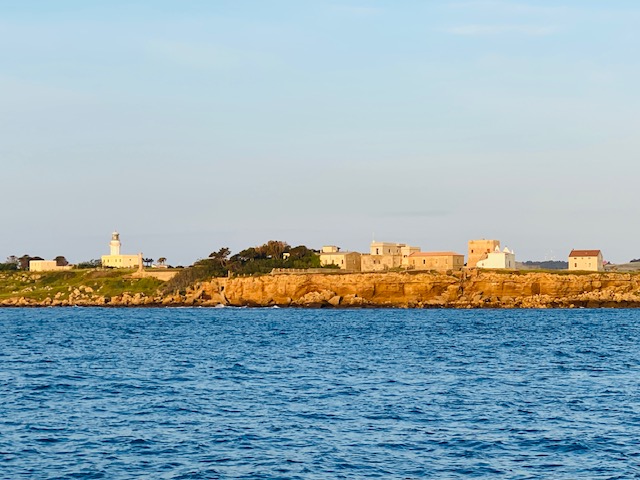

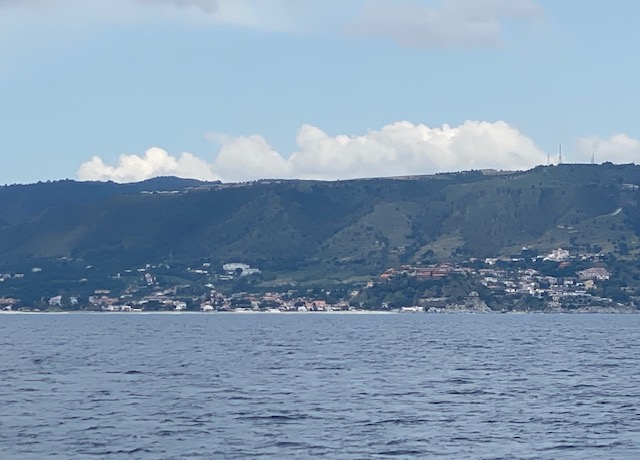








As usual we started off motoring, but as the morning progressed we were able to motor-sail. At one point, though, with full sails up, on a beam reach, in 10 Kts of wind, we sailed. Unfortunately that didn’t last long and the mainsail started to flop around in less than 5 Kts of wind, exacerbated by the short, steep swell we had on the beam.
With the mainsail down and on the trusty headsail alone again, we continued on; there was no time to dilly dally today, given that we had just over 70nm to cover.
At 0800 Roy went for a nap; he didn’t have a good night’s sleep at all, although Elaine was dead to the world. She vaguely recalls hearing Roy wandering around and muttering something about wanting to know where the yacht was; clearly he’d forgotten we were tied to a dock.
By 1100 we were at the halfway mark, but with the uncomfortable sea state and bouncing around all over the show, Elaine postponed doing the laundry, although we did manage to run the watermaker.
By 1445 we could see land again and thankfully the sea state had started to settle down.
By 1630 we were anchored off the very unattractive looking town of Crotone, with its shabby looking high-rise buildings jammed together along the waterfront. We hadn’t intended to go ashore, but after our initial impressions, we decided we were definitely not going ashore. Instead, we had an early dinner onboard and a reasonably early night. However, the swell made for a very rolly, uncomfortable night, precluding us from a good night’s rest and the fireworks set off at midnight didn’t help matters either.
The highlight of our day, though, was a virtual tour of the Cadman Jr household’s new home, with running commentary from our grandson, William. This was followed by a chat to Brooke and the twins, who seemed very preoccupied with whatever it was they were doing. Having seen the new home in various stages of construction when we visited in March, it was nice to see it furnished and everyone more settled again.





Adjacent to the lighthouse was the large stone sanctuary or basilica, Santuario di Santa Maria de Finibus Terrae (End of the Land), built from 1720-1755, with a beautiful open courtyard and, more importantly, a cafè.
While it was a little bit of a struggle for Elaine to get to the top, she was delighted she made it and the views were absolutely worth it.
After looking around the lighthouse, although there was no access to it, since there is a live-in lighthouse keeper and the property was fenced off, we could access the basilica, where Elaine said a little prayer for our safe onward passage to the Caribbean. It was the first Catholic Church we’d been able to access since leaving Sydney, Australia, in February 2018; the cathedral in Penang, Malaysia, had all sorts of restrictions during the COVID-19 pandemic, which basically put it out of bounds for us.
Deciding the steps were not a good idea for Elaine to get back down, we opted for a walk along the road, seeing a few more lovely homes perched on the hillside, but not before we’d enjoyed a coffee and baked delight at Caffé De Finibus Terrae, while enjoying the views.
Back onboard we enjoyed a restful morning, including a nap, then spent the afternoon cleaning Paw Paw inside and out; she was covered in desert dust, but she was all sparkling clean again by early evening. Not sure how long she’ll stay that way, but she was, at least, presentable again.
After showering and getting ready, we took a stroll along the waterfront, before enjoying a delicious seafood dinner at the Santa Maria di Leuca Restaurant overlooking the bay. It was a lovely warm evening to sit on the balcony to enjoy the views and our meal.
It was the perfect ending to a relaxing day and a nice break from motoring across the Mediterranean Sea.
















Once daybreak broke, though, being a methotrexate day for Elaine, she went back to bed after feeling very queasy, exacerbated by a flat sea with a lazy swell.
After breakfast it was Roy’s turn to take a nap, both rather relieved that we didn’t have to do an overnight to Italy as originally planned, given our fatigue levels at this point. On the bright side, it was a beautiful sunny day, with warm temperatures; it seemed we were almost ready to break out our summer wardrobes at last.
By 1140 we had crossed into Italian territorial waters and, although we’d turned our clocks back by an hour and hoisted the Italian flag, with just over 20nm to go, we still couldn’t see land. However, by 1230 Italy was in our sights! The downside was that we had not received confirmation of our request for a berth in our chosen marina, even after trying to call them; no one spoke English. This meant we weren’t entirely sure what awaited us. Fortunately, that all changed about an hour before our arrival when we received confirmation of our reservation.
Of course, we also had the usual numpty cutting across our bow and forcing us to slow down on this occasion. The corker was that the tanker then turned to starboard after crossing our bow, confusing us as to why it came so close to begin with, when a course alteration to the southwest could have missed us by a country mile.
Approaching and entering the Porto Touristico Marina di Leuca in the town of Santa Maria di Leuca was an experience. First, we didn’t receive a response to our radio calls until we were entering the marina, when we received instructions to: “Go to the first pontoon”. Not having a clue as to which of the two pontoons we saw as we entered; one to our starboard side and one to our port, fortunately Roy spotted the marinero waving at us frantically on the port side pontoon.
However, once Elaine had reversed Paw Paw to Med moor, someone from the large group of marineros, which we assumed were there to assist us, handed Roy the first mooring line to tie to the port bow, then stood and watched as he ran around the deck tying off the other lines; no dinghy assistance, no mooring line assistance, absolutely nothing!
Next was the instructions we received to check in at the marina office before it closes at 1600, so off we rushed. When we got there, the office was closed. A little confused we decided to walk to the Ufficio Locale Marittimo Leuca (the Local Official Maritime Office of Leuca) after receiving directions from one of the marineros to obtain our Constituto Di Arrivo (aka Transit Log), but that turned out to be a waste of time too, since the officials were adamant we didn’t need one, because: “The UK is part of Schengen and we have a UK flagged yacht”. Clearly they hadn’t heard of Brexit and no matter what we said, we were reassured we didn’t need any documentation; who were we to argue!
Returning to the marina we stopped by the office again, only to find it still closed. Apparently something was lost in translation; the office only opened at 1600, not closed at 1600. Afternoon siestas were clearly taken seriously here!
We had enjoyed a lovely walk, though, along a maze of suspended wooden bridges, seeing numerous beautiful mansions all along the hillside, as well as enjoyed the beautiful seascape views over Porto di Leuca.
Research revealed that Santa Maria di Leuca was founded in the early 1st century AD by some monks, after Saint Peter's passage. According to a later legend, Virgin Mary once saved some boats from a storm, and her name was added to that of Leuca.
The town, however, is famous for its iconic lighthouse, the Faro Capo Santa Maria di Leuca, constructed in 1866 and sits on Punta Meliso, which we could see as we approached Italy. At a height of 47 metres and standing 102 metres above sea level, it is considered the second most important lighthouse in Italy, after Genova.
Next to the lighthouse is the large stone sanctuary or basilica, Santuario di Santa Maria de Finibus Terrae (End of the Land), built from 1720-1755, on the site of an ancient temple, to commemorate the passage of St Peter during his travels through Italy. It is devoted to Saint Mary and is connected to the port through a 284-step staircase.
Punta Meliso is the southeastern extremity of Italy, traditionally considered the lowest point of the geographical "heel" of the Italian peninsula, as well as the meeting point of the waters from the Ionian and Adriatic Seas. However, this is disputed by some, since Punta Ristola, the promontory on the other side of the bay, is 440 metres south of Punta Meliso.
Since October 2006 Santa Maria di Leuca forms part of the Regional Park, Costa Otranto - Santa Maria di Leuca e Bosco di Tricase, given the historic significance of Santa Maria di Leuca's shoreline, marked with numerous grottoes with Latin and Greek inscriptions found inside them. The town is also famous for the 19th century “patrician” villas, the beautiful mansions we saw during our walk. Apparently there are around 43 of them, but Elaine couldn’t find any further historical reference to them.
Our day ended witnessing the worst Med mooring manoeuvre we’ve ever seen by any yachtsman, resulting in the motor-cruiser, which was attempting to reverse into the berth to the starboard side of our floating neighbour, ending up sideways across the back of our floating neighbour, almost hitting Paw Paw’s starboard topside and its propeller wrapped around the port side mooring line of our floating neighbour. It was definitely the worst example of situational awareness we had ever seen and we all sighed a sigh of relief when the cruiser was eventually tied securely in its berth. Even the marineros were shaking their heads and throwing their hands in the air, in true Italian style, as this old fool tried again to reverse into the berth, once we’d helped get the motor-cruiser off the tangled mooring line, but then t-boning his bow into the boat to his starboard side. The laugh of it all, though, was that the yachtsman was in his underpants that were half stuck up his rear-end and his wife was standing on deck, in a complete daze, waving a boat hook around aimlessly. It truly was a pantomime! We couldn’t stop giggling afterwards and decided that we never wanted to be that age while still trying to sail and completely clueless in the process. I’m sure they were both competent sailors at some point in their lives, but they were way past their “sell by” date and, sadly, didn’t know it.









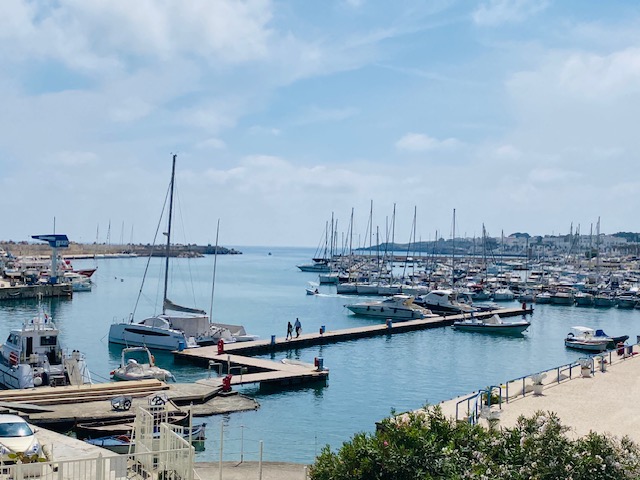







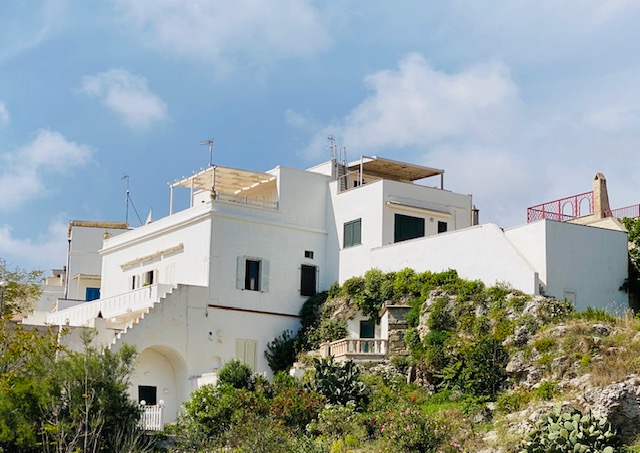


Fortunately the winds and swell switched back to the northwest during the night, so we woke to a completely calm bay, but, instead of enjoying a sleep-in, we decided to weigh anchor and head to the city of Corfu anchorage just off the Old Port, only a two hour motor away, where we’d have breakfast and enjoy a little bit of R&R before dealing with all the officialdom of clearing in and out, getting provisions, etc.
Well, we arrived at the designated anchorage at around 0800, but after four attempts at trying to set the anchor as it dragged through thick weed, we eventually gave up an hour later, with no other choice but to continue north to the next anchorage, in the hope that it wasn’t a weed or rocky bottom too.
Thankfully, though, as we rounded the beautiful old fortress sitting on the northern end of the bay, Roy spotted a few yachts anchor just north of a little marina for small power boats. It was definitely not the most picturesque anchorage we’ve ever been in, but it was practical; it had a sand bottom, there was plenty of swing room, it wasn’t overcrowded, it was quiet and it was within walking distance of everything we needed onshore. Perfect!
By now, though, it was 1000, we were both starving, given that we still hadn’t had breakfast, we were still fatigued from our eventful day yesterday and we’d just discovered all the grocery stores were closed, being a Sunday; our frustration levels were now off the scale!
So, after taking a deep breath and having a bite to eat, we changed our plans again, but we were going to enjoy some R&R no matter what. That came in the form of a tour around the city of Corfu on the Hop On Hop Off bus, after we’d cleared into Corfu with the Port Authorities, although we didn’t hop on or off anywhere; we simply enjoyed the ride.
From the New Port, where three cruise ships and numerous ferries were docked, our tour took us passed the Old Port, where we’d struggled to anchor, the New Fortress, the Mon Repos Palace, the ruins of the first Christian Church, the Paleopolis Roman Baths and on to Kanoni, then followed the coastal road back to the entrance of the Old Fortress, the Eosketo Garden, Corfu Old Town and Spilia Square.
As we travelled, the audio guide provided some history on Corfu, known as “Kerkyra” in Greek and owes its name to the Nymph Korkira, the daughter of the River god, Aesopos. According to Greek mythology, Poseidon, god of the Sea, fell in love with Nymph Korkira, kidnapped her and brought her to Corfu Island.
Corfu Island forms the northwestern frontier of Greece and, as we sailed north, we passed the border between Greece and Albania, which meant that the landscape we could see from our anchorage looking east was, in fact, Albania.
Corfu island has a history marked by numerous battles and conquests over the centuries. The medieval castles, punctuating strategic locations across the island, are a legacy of these struggles, but made it one of the most fortified places in Europe, successfully repelling the Ottomans during several sieges; Corfu was never occupied by the Ottomans.
It was, however, conquered by the Macedonians, under the rule of King Philip II, in 338 BC. From 300 BC, Corfu was successively attacked and conquered by Spartans, Illyrians, and Romans, the latter staying on the island from 229 BC to 337 AD.
In 40 AD, Jason and Sossipatros, two disciples of Saint Paul, brought Christianity to the island and built the first Christian church, which they dedicated to Saint Stephen.
Corfu was also under Norman and Venetian rule, until 1267, when Charles of Anjou, the French King of Sicily, took the island before it returned to Venetian rule again in 1386. Corfu stayed under Venetian domination for four centuries, bringing the Venetian architecture, culture, language, music and cuisine to the island. Operatic music and playing a classical instrument has remained an integral and important part of life on Corfu Island, where children learn to play an instrument from a very young age.
In 1797, the island became part of the French State, before the British, who had already started to occupy the other Ionian Islands, reaching Corfu Island in November 1815, following which the island came under British rule. Eventually, on 21st May 1864, the Ionian Islands were ceded by the British to the new King of Greece under the Treaty of London.
Besides the island’s history, the Mon Repos Palace has a fascinating history too. The villa was built from 1828–1831 as a summer residence for the British Lord High Commissioner, Frederick Adam, while the island was under British rule, but rarely used as a residence for later British governors, although Empress Elisabeth of Austria stayed there in 1863 and later built the Achilleion Palace.
After the union with Greece in 1864, the first King of Greece, George I of Hellenes used it as a summer residence, but renamed it "Mon Repos" (French for "My Rest"). It was used by the royal family up until King Constantine II fled the country in 1967.
Several royal births took place at the palace, including the late Prince Philip, Duke of Edinburgh, who was also baptised at the palace as well, and Princesses Sophia and Alexia of Greece and Denmark.
Corfu Island is also known for its diverse and exotic trees and plants. As we drove around there were plenty of lush green areas to be seen around the city, including numerous tree lined streets.
Once our tour was complete, we walked to Sette Venti, a boulangerie and patisserie we’d seen from the bus, to enjoy a coffee and a delicious baked delight.
While we enjoyed seeing the old and new fortresses, the ancient ruins, the beautiful gardens and pretty homes painted in pastels, these were interspersed with rundown, dilapidated buildings, giving the city a grubby feel, the worst of which was in the Old Town; the majority of the beautiful old Venetian buildings, portraying the Venetian architecture, were not maintained at all and in complete disrepair. Such a pity, compared to the Old Towns of Panama and Antalya we so enjoyed.
The city was also busy, noisy and congested and, to be honest, we didn’t feel like we were on a Greek Island; we could have been in any city anywhere in the world, making this our least favourite stop in Greece.
After returning to Paw Paw, we both enjoyed a much needed afternoon nap, then enjoyed a barbecue onboard for dinner before heading to bed.





























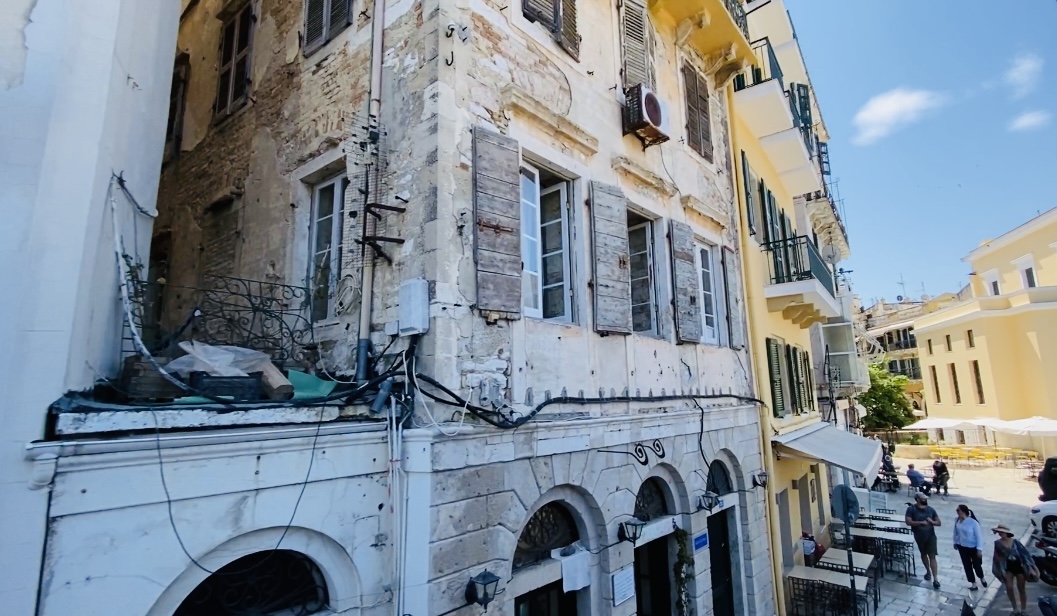

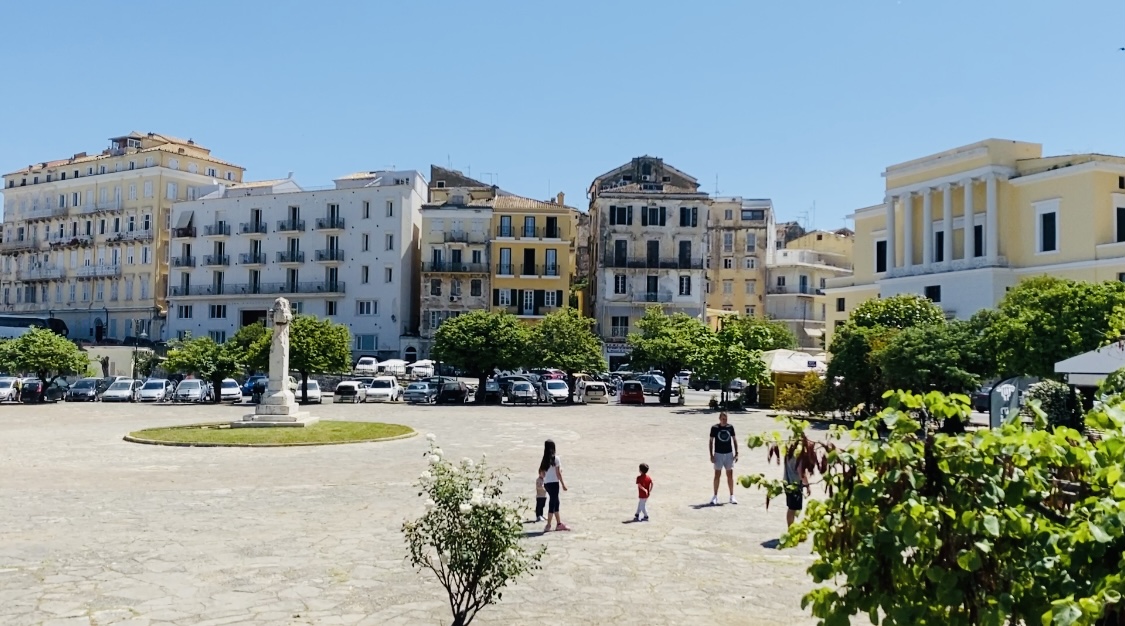
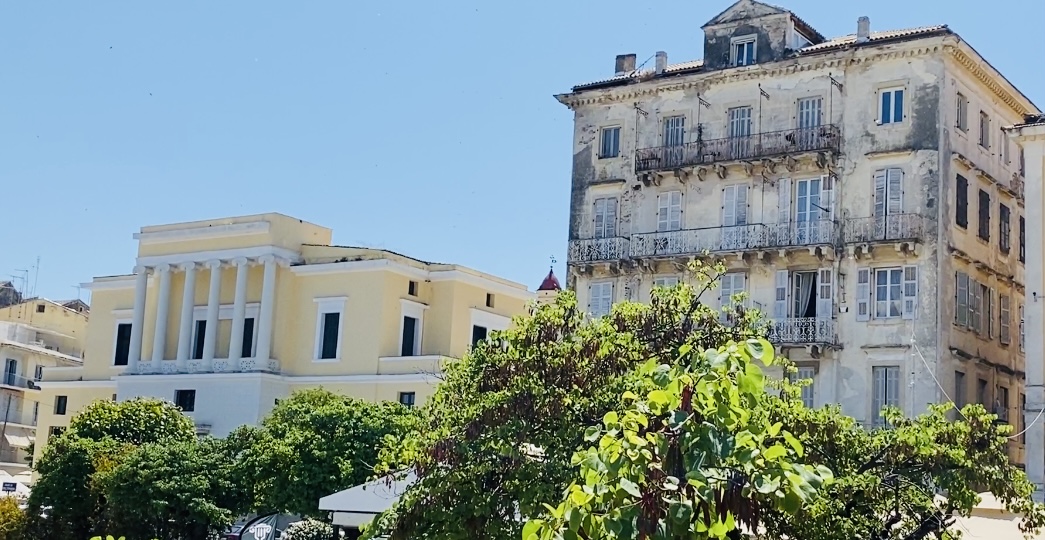
After breakfast we dinghied ashore and walked to the New Port, where we cleared out of Corfu Island at Port Authority, then walked to the nearby Customs office to clear out of Greece, giving us 24 hours to leave their territorial waters.
From there we walked to the cruise ship terminal, where we’d started our Hop On Hop Off tour yesterday, knowing we’d find a taxi in the vicinity to take us to the Lidl’s supermarket to complete our provisioning.
It was lovely to find a different variety of food that we haven’t eaten in a while, including smoked salmon, salami sausage, pork chops, digestive biscuit, French and Dutch cheeses and a variety of European chocolates, to mention a few.
Then, after walking back, loading and unloading the dinghy, but not before we had enjoyed an ice-cream while floating back to Paw Paw, given that we were enjoying the hottest day of the year thus far, at 25C, we weighed anchor at around 1000 and set off for our overnight anchorage on the west coast of Corfu Island.
As we motored north, then west, we could see settlements and a fairly large town on the Albanian coast, as well as beautiful bays with sandy beaches at their heads along the coast of Corfu Island and picturesque limestone cliffs that continued along the coastline as we turned south, concluding that this was the attraction of Corfu Island, as apposed to what we’d seen during our land explorations. Unfortunately, with the prevailing winds, these bays were unsuitable as anchorages.
By 1600 we were anchored in the stunning, large horsehoe bay of Geórgios, surrounded by rocky outcrops and vegetation clad mountains, off the little village of Afiónas. It was one of the prettiest bays we’d seen during our travels through Greece and, fortunately, given the very calm weather conditions, was tenable for our visit, with good holding in sand and plenty of swing room, given that there were only four other yachts in the anchorage.
Once settled, we beached the dinghy, enjoyed a walk along the golden sandy beach that ran the full length of the bay, before choosing San George Food Bar, one of the many boutique hotels’ bar, restaurants and cafés running along the beachfront, for a sundowner and celebratory drink, the latter in lieu of the fact that we’d made it through Greece before our Cruising Permit and Transit Log had expired, saving ourselves a substantial amount of money on import taxes. A delicious dinner was then enjoyed at Kali Orexi before returning to Paw Paw for a hot shower and early bedtime; it had been another busy day and we had a very early start in the morning.




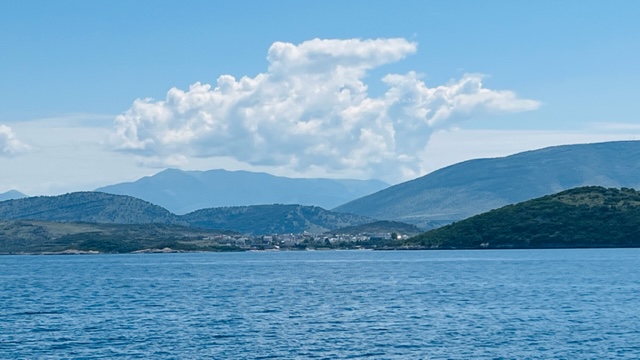




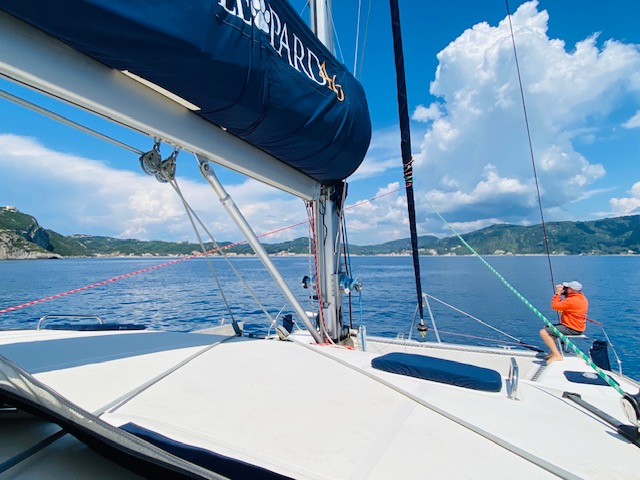










Enjoying a beautiful sunrise and picturesque scenery, we trundled up the channel to the bridge, arriving a little early, but holding back a few hundred metres since, although we understood this was a swing bridge, we weren’t altogether sure which way it would swing.
Having contacted Bridge Control to inform them of our intentions, at precisely 0800, the sirens sounded and the west side of the bridge started to lift, before the remainder of the bridge swung towards us and we were able to pass through. It was a bit of an obstacle course, but within minutes were were back in open water, having passed another ancient castle to our starboard side, located at the northern entrance to the channel; another lovely surprise.
Setting course for Preveza, on the mainland, where we needed to stop for diesel, was the next task of the day. It didn’t help matters, though, that the first fuel dock we approached was closed.
After being referred by the marinero, we changed plans and headed northwards over the large bay to the Preveza Marina, where a very pleasant young man, who spoke very good English, assisted us. Changing plans, however, became the norm for the rest of the day.
Originally the plan was to set sail for Paxos Island after filling up with diesel, a very expensive exercise mind you, at 50% more expensive than anywhere else in the world where we’ve filled up. However, by 1745 we’d weaved Paw Paw in and out of every anchorage available on Paxos Island, but to no avail.
As a standard practice aboard Paw Paw, before setting sail anywhere, besides checking what the expected weather should be en route, as well as the weather at our next destination, we research and examine every viable anchorage for the expected conditions, ensuring those anchorages are orientated in such a way as to provide the best protection, we determine whether the bottom is sand, mud, rock, weed or a mixture, we determine the size of the anchorage, which provides an idea of swing room and we collate information from other cruisers, who have visited the anchorages previously, on the general area in terms of scenery, activities available, amenities ashore, etc. To do this we use a variety of sources, which usually include cruising guides, pilots, our electronic charts, online blogs that cruisers create and, more recently, the Navily application, which we understood to be the ”go to de factor standard” for the Mediterranean.
Well, having completed our due diligence as usual, what we found on Paxos Island was no comparison to what our research had revealed; every anchorage was minute, with barely enough room for 1-3 small yachts, given that most of the space was taken up by local boats and fishing pods. There wasn’t enough room to swing a cat, never mind shoehorn Paw Paw in anywhere and Elaine is pretty adept at doing that.
Instead, another change of plan; head for Corfu, the most northerly Island in Greece and defining the border between the Ionian Sea and the Adriatic Sea. This decision not only changed our plans for the day, but changed our strategy and all the arrangements already put in place for our imminent departure to Italy. We had planned on an overnight sail to bring us into the southern part of Italy at the “sole of the boot”, as apposed to “the heal”. Leaving from Corfu, however, has the advantage of negating the need for an overnight sail, but the distance we’ve sailed north requires us to re-sail it south, once we reach Italy, adding unnecessary nautical miles to our overall passage through the Mediterranean.
It didn’t help matters that our journey northwards to Corfu was in a thunderstorm, with howling winds on the nose, in churned up seas, which made the anchorage we’d chosen off Corfu Island extremely uncomfortable as the wind and swell turned northeast ie straight into the anchorage, that had every yacht bouncing around and making it extremely precarious to get to shore for a very late dinner. Fortunately our anchor spot was in sand, with plenty of swing room and directly opposite a very sturdy dinghy dock belonging to a highly recommended taverna, Panoramic, where we, not only had the most delicious moussaka, but a chilled alcoholic beverage, which we both desperately needed at this point; we were well and truly over motoring through Greece, in unpredictable and unpleasant weather conditions. On the bright side the temperatures had increased quite dramatically the further north we progressed, reaching the early twenties and forecast to reach the mid-twenties tomorrow; warmth at last! This, of course, could be a case of: “Careful what you wish for“.
Back onboard, a cup of tea before bedtime sealed a very eventful, hectic and frustrating day.




